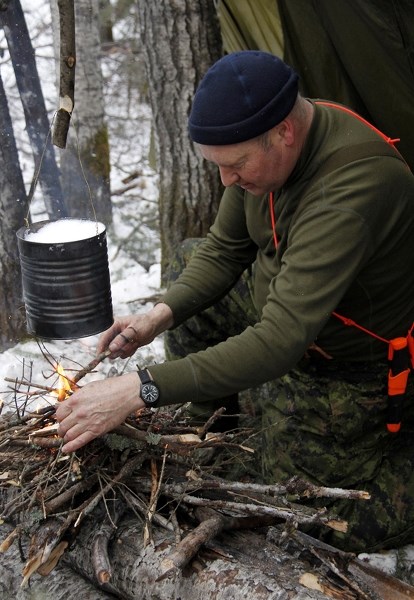Anyone may find themselves in a survival situation, but those with the 4-Wing Ground Search and Rescue (GSAR) team know how to survive.
On an isolated area of the Cold Lake Air Weapons Range, the smell of a signal fire filled the air last week, indicating crews were ready to be rescued. Flash back 72 hours, and the students of the 4-Wing Exercise Frosted Flier are just starting their survival journey.
On Jan. 17, members of the GSAR team were taught how to survive substantial cold weather, exposing them to the psychology of survival, as well as cold weather injuries and treatment. Exercise Frosted Flier starts by teaching GSAR members how to instruct the survival course. They learn the basics of building a fire, a shelter, and how to spend a night in the freezing temperatures of the Canadian winters. Once they have completed their three-day course, they build a signal fire, so they can be found in emergency situations by an airborne search and rescue team.
Master Cpl. Jonathan McArthur, operating officer in command for the 4-Wing GSAR team, said they focus on the six components of survival: self-aid/first aid, fire, water, shelter, signals and food.
GSAR members who took the course last week, now transition into instructors for the Frosted Flier. Running from through to Feb. 3, they will teach pilots and aircrew how to survive in winter conditions.
For years, GSAR members have been partaking in the course that isolates them from society. They are given the necessities to survive; rations, rope, a parachute, and a saw, and are left in the woods for 72 hours. The only contact they will have is with their instructors, who will stop in and check on the students' wellbeing.
While a pilot may not have all of those items on hand if they were forced to eject from an aircraft, for training purposes they were provided.
Using their tools and surroundings, students are required to build a shelter, fire, and a reflecting wall for warmth and protection from the elements.
“In the case of an ejection, a pilot needs to be able to use the equipment he has available to survive out there,” said Master Cpl. Mark Kerr, who, as a member GSAR, is mandated to take the training.
While many would think some of the greatest struggles would be obtaining water or staying warm, McArthur said one of the biggest hurdles for students is unplugging.
“For some, this is the first time they have been unplugged… so the only interaction these guys will have for the next three days, is with the instructors when they come out to do medical checks,” he explained.
McArthur added one of the necessities for a successful survival is having a positive mental attitude, and the ability to say, “this isn't so bad.”
Some fair better than others, but with the help of the instructors, students struggling are able to focus on the task at hand and complete the course.
Time management is also important throughout the course of the program. Without the use of a watch, students are left to their own devices for telling time, such as sunlight, which at this time of year is very limited. This means that any work that needs to be done has to be completed quickly.
Kerr recommends survival training for anyone fascinated by the subject, and although civilians are not allowed to take part in Exercise Frosted Flier, there are other options available.
“Just go out there and try it. You could be driving from Cold Lake to Edmonton, and you could be in trouble, the skills you learn here can serve you outside of just a survival situation. It is just being generally prepared for situations that come your way.”
He continued, “With the right skills and the right equipment, the right knowledge and the right mind set… that will to keep going… anyone could be out here doing it.”



